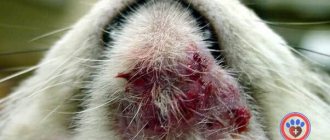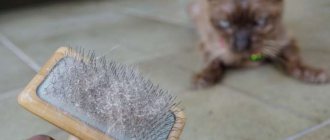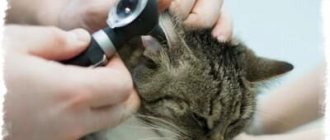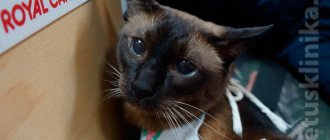27.08.2019
Skin diseases in cats
no comments
8267
Cat chin acne is a common skin condition in the feline species. To be more precise, this is the most common manifestation of acne in cats. It can appear at any age and the gender of the animal does not matter. The disease can get worse, worse, or even be extremely difficult to treat. Signs and symptoms range from barely noticeable comedones (blackheads) to severely inflamed and debilitating pustules. Some cats are not bothered at all, while for others, the pimples are very itchy and painful. Localized hair loss and skin redness are also common.
What is stomatitis
Stomatitis in a cat is an inflammatory disease of the oral mucosa (usually the corners of the mouth, lips, tongue, gums, lingual palatine folds) with possible complications in the absence of proper treatment. It is contagious to animals, so a sick cat should be protected from contact with other pets.
According to localization, the types of the disease can be classified as follows:
- gingivitis - inflammation affects the gums of the animal;
- gingivostomatitis - inflammation covers the mucous membrane of the entire mouth and gums;
- glossitis - affects the tongue;
- palatinitis - affects the palate;
- faucitis - in this case, the palatoglossal folds are subject to inflammation;
- cheilitis - inflammation affects the lips.
According to the duration of the disease, the disease can be acute - up to 2 weeks, subacute - 2-6 weeks, and chronic - more than 6 weeks, in which the animal generally feels unwell.
Symptoms of acne in cats on the chin
Many cats first develop a slightly dirty chin, covered in small black spots between the hair follicles. Sometimes, symptoms in cats are limited to just this manifestation. In other cases, it may begin to progress into swollen, red lumps that begin to rupture and bleed.
If the problem continues to progress, it is likely that the follicles may become infected with Staphylococcus aureus. This is a fairly common bacterial infection that can usually be found on the surface of the skin. This complication is called bacterial folliculitis. This serious skin infection requires more aggressive treatment. Folliculitis can also lead to secondary fungal infections if not treated properly.
Main signs of the disease
You can assume that a cat has stomatitis based on the following signs:
- loss of appetite;
- constant thirst appears;
- the cat often rubs its muzzle with its paw or rubs its muzzle against objects/the floor in an attempt to relieve pain;
- temperature rises;
- lack of washing and hygiene due to pain in the mouth;
- increased salivation;
- constantly wet fur around the mouth;
- apathy and drowsiness;
- pinkish saliva - due to bleeding wounds - or viscous and yellowish - due to an admixture of pus;
- swollen lymph nodes in the jaw and neck.
“Murkoshi” volunteers carefully care for each animal and recommend that cat owners not delay visiting the veterinarian if symptoms of illness are detected.
Feline calicivirus
Viral diseases are widespread. This is partly facilitated by the negligence of owners who believe that a cat that lives at home and does not walk outside does not need to be vaccinated. Vaccination is necessary, since you can bring the virus on shoes and clothes from the street. The most common diseases: panleukopenia, herpesvirus, calicivirus. Let's talk about the latter today.
Viral diseases are widespread. This is partly facilitated by the negligence of owners who believe that a cat that lives at home and does not walk outside does not need to be vaccinated. Vaccination is necessary, since you can bring the virus on shoes and clothes from the street. The most common diseases: panleukopenia, herpesvirus, calicivirus. Let's talk about the latter today.
Feline calicivirus is a highly contagious disease of the respiratory system of a viral nature, usually affecting the respiratory system, with signs of damage specifically to the upper respiratory tract, but also with calicivirus, cats may have ulcers in the mouth, on the tongue, on the nose, and in severe cases, pneumonia , sometimes arthritis.
Transmission routes
Animals that lead a crowded lifestyle are most susceptible: foster homes, shelters, nurseries. The virus does not survive well in the environment and dies within 3-10 days. It is excreted mainly with saliva and nasal discharge. The route of infection is contact, through household items: bowls, trays, etc. Cats can also get sick through direct contact (when sneezing, microparticles fly over a distance of more than a meter) or through the clothing of people caring for the cat. By interacting with an infected cat on the street, you can bring the virus to your domestic cat. In some cases, cats can shed the virus into the environment for life, while some become ill and the virus completely disappears from the body.
Symptoms
Symptoms may be similar to other respiratory infections:
- Temperature increase.
- Lethargy and apathy.
- Decreased or complete absence of appetite.
- Sometimes diarrhea appears, which is replaced by constipation after two or three days.
- The appearance of painful ulcers in the mouth, lips, nose, mucous membranes of the prepuce and vagina.
- Bleeding from ulcers, putrid odor from the mouth, inflammation of the gums.
- Profuse drooling.
- Sneezing.
- Crusts in the area of the nostrils, eyes.
- Tearing.
- In some cases, lameness is noted.
Differential diagnoses It is necessary to distinguish calicivirus from other diseases:
- Gingivostomatitis in cats.
- Eosinophilic granuloma complex.
- Chemical or thermal burn.
- Herpesvirus.
- Chlamydia.
- Neoplasia.
- Viral rhinotracheitis of cats.
- Bortedellosis.
The weaker the immune system, the more body systems will be involved in the disease. Respiratory system - rhinitis (inflammation of the nasal mucosa), interstitial pneumonia (pneumonia) - dangerous, ulcers on the tip of the nose. Damage and inflammation of the eyes - acute serous conjunctivitis, lacrimation, but without keratitis (inflammation of the cornea) or corneal ulcers. Musculoskeletal system – acute arthritis (inflammation of the joints), lameness will appear. Gastrointestinal system – ulcers of the tongue (often), sometimes ulcers of the hard palate and lips; The intestines may also be damaged, but without clinical signs (no diarrhea). Sometimes ulcers occur on the head and limbs, skin swelling, accompanied by severe fever. The onset of calicivirus in both adult cats and kittens is sudden, refusal of food, hyperthermia (temperature rises to 40 degrees Celsius).
Treatment
Unfortunately, there is no specific treatment aimed at destroying the virus that causes calicivirus. The therapy is comprehensive, aimed at eliminating symptoms and helping the body fight infection. Ulcers are treated locally with healing preparations. Systemic antibiotic therapy is necessary to prevent the development of secondary bacterial infection. Anti-inflammatory drugs for arthritis. Intravenous infusions of solutions for dehydration. Instilling drops into the nose is ineffective; inhalations provide more benefit, provided that the cat agrees to them. If there is discharge from the eyes, it may be necessary to instill an antimicrobial drug.
- Treatment is carried out on an outpatient basis, except in cases of severe pneumonia. For pneumonia, treatment must become more aggressive, since the severity and danger of the disease increases several times. The danger of the disease for kittens is higher than for an adult cat; more attention should be paid to a kitten with calicivirus. Only complex treatment gives positive results.
Prevention
Since the disease is very contagious, it is necessary to thoroughly treat household items and rooms where the cat lives with disinfectant solutions.
Newly arrived animals must be quarantined. Not only because of the risk of the incubation period of calicivirus, but also other infections. On average, isolation is required for a month. Important attention should be paid to preventive vaccination. The most common cat vaccines protect against calicivirus. Kittens need to be vaccinated from the age of two months, revaccination is carried out after 3-4 weeks, and then an adult cat is vaccinated every year. Females are vaccinated before mating. Isolation of newborn kittens from older kittens and adult cats until these kittens are vaccinated and the vaccine has its effect.
Reduce stress factors as much as possible, avoid overcrowding of animals.
Observe zoohygienic standards when keeping animals in groups, ensure timely disinfection of utensils, premises, and care products.
Causes of stomatitis
Stomatitis in a cat occurs due to any injury or disease. Depending on the causes of the disease, primary and secondary stomatitis are distinguished.
Primary develops when:
— thermal burn (too hot food or inhalation of steam);
— chemical burn (swallowed alkaline solutions, salts of heavy metals, etc.);
- mechanical trauma to the mouth (bad bite, damage to the gums or cheeks from small bones while eating).
Secondary stomatitis in kittens and cats develops against the background of stress, weak immunity or as a result of diseases:
- diabetes mellitus and other difficulties with the endocrine system;
- lack of vitamins (as a rule, stomatitis can be caused by a lack of A, B, C, E and PP);
— infectious (calcivirosis, rhinotracheitis, papillomatosis, etc.);
— renal failure and diseases of the gastrointestinal tract (colitis, gastritis, etc.);
- allergies to medications, food or, conversely, inedible products (plants, shampoo, paint from toys, etc.);
— problems with gums and teeth (periodontitis, periodontal disease, caries, etc.);
— oncology, especially in the neck and head;
- autoimmune diseases.
Stomatitis can also be caused by poor oral hygiene or feeding from dirty dishes. It is necessary to introduce specialized food into the cat’s diet that prevents the deposition of tartar, or to remove it in a timely manner at a veterinary clinic.
Read more: Removing tartar from a cat
Symptoms and diagnosis
The symptoms of rhinotracheitis or eosinophilic granuloma have a number of differences. So, with rhinotracheitis, in addition to ulcers in a cat, coughing, sneezing, and copious discharge of mucous secretion from the nasal passages occur. There is increased lacrimation and decreased appetite. It is possible that body temperature may increase and the animal may become apathetic and drowsy. Untimely measures taken to eliminate rhinotracheitis provoke the development of dangerous complications.
Against the background of an advanced herpes virus, pathologies of the digestive tract of the chronic type develop, and the development of inflammatory processes in the pulmonary structures is also possible.
External signs of rhinotracheitis in cats are characterized by ulcerations on the mucous membrane of the oral cavity and tongue, and the cornea of the eye is affected. Convulsive phenomena may occur in the forelimbs, and more often, the hind limbs. Gait and coordination of movements are impaired.
An ulcer on the lip due to herpes in a cat causes severe discomfort to the animal. The wound itches, hurts and quickly spreads through the soft tissues. A bubble with exudate is formed, which then bursts and exposes damaged tissue. An open wound is a gateway to bacterial or fungal infection.
There is no complete cure for the herpes virus. The animal becomes a carrier of infection for life. It is necessary to treat the disease, as this makes it possible to suppress and weaken the virus. The insidiousness of the rhinotracheitis virus (herpes) lies in its penetration through the skin to the nerve endings. Passing along nerve fibers, viral agents settle in the nerve plexuses, being in a latent state, waiting in the wings.
Another disease, eosinophilic granuloma, is characterized by the absence of pain in the cat while eating. Jacobs disease is considered an autoimmune process that develops in response to allergic substances or parasite toxins.
Veterinary experts around the world are inclined to the hypothesis that Jacobs disease has a predisposition at the genetic level. A hyperemic spot on an animal’s lip quickly grows, begins to deepen and becomes inflamed. With eosinophilic granuloma, ulcer healing occurs very slowly.
Advanced cases of Jacobs disease in cats involve damage to the upper lip to such an extent that the teeth and even gums become exposed.
Making a diagnosis involves a thorough examination of the animal and specific laboratory tests. If rhinotracheitis is suspected, the veterinarian conducts a general and biochemical blood test, so biological material is collected to determine the virus that caused the disease.
Eosinophilic granuloma is diagnosed less frequently and is more severe. As a rule, diagnosis consists of collecting anamnesis and other observations. An antibody test can be performed to identify a possible allergen.
Treatment of stomatitis in adult cats
As Henry Bates said, “Cats are happy creatures. They don’t care about anything at all!” And this is true - until the cat gets sick. Furry pets are not always able to help themselves on their own, and then they need the care of their owner. Well, his duty is to follow the veterinarian’s recommendations.
Depending on the type of stomatitis in a cat, its severity and the general condition of the animal, the doctor may prescribe medication - including drugs and immunomodulatory drugs, surgery - when removal of the affected mucous membrane, tartar or teeth is required, or combination therapy - consisting of surgical intervention followed by prescription of medications.
Widely used drugs for the treatment of stomatitis in cats:
- Antiviral, antimicrobial, antibiotic and antifungal
— “Amoxicillin” 15%. 1 time subcutaneously or intramuscularly, dosage 1ml/10kg (or 15ml/kg).
- "Oxytetracycline." A course of 3-5 days, 1 ruble/day at a dosage of 0.1 ml/kg.
— “Lincomycin” 10%. Dosage intramuscularly – 2ml/10kg, intravenously – 1ml/10kg. Course 3-7 days.
- Oxolinic or Nystatin ointments, "Cholisal". Apply locally, a thin layer to inflamed areas.
- Antiseptics
— “Chlorhexidine” (0.05%). Rinse mouth or treat wounds topically.
- "Dentavedin-gel." 2-3 times a day, apply a thin layer to sore gums or into the sockets of extracted teeth.
— “Lugol” with glycerin, including spray, “Metrogil-denta”, “Protargol” (1.5%). Spray or smear on ulcers.
- Restorative and wound-healing drugs
- “Actovegin-gel”, “Levomekol”, rosehip and sea buckthorn oils. Apply a thin layer to ulcers and wounds when the inflammation has passed.
- Drugs to enhance immunity
- "Kathozal". 0.5-2.5 ml/cat, once. If necessary, repeat after 3-5 days.
- “Gamavit.” 0.3-0.5 ml/kg 1-3 times every 7 days. Course from 2 to 4 weeks.
- “Hemobalance. 0.25 ml/cat weighing up to 5 kg and 0.5 ml/cat over 5 kg, 2-3 times a week.
- For stomatitis that has developed against the background of autoimmune diseases, the following drugs may be prescribed:
- Cyclosporine. 7 mg/kg 1 time per day. The course is from 4 to 16 weeks (depending on the severity of the disease).
- “Prednisolone.” To suppress inflammation – 0.5 mg/kg 2 times a day. For complete treatment – 1-3 mg/kg twice a day.
- Painkillers and disinfectant sprays
— “API-SAN”, “Candioli”, “Zubastic”, “Oral-Relax”.
- Vitamins
Features of treatment
The basis of treatment is systemic and local antifungal drugs. Today they are widely represented on the pharmaceutical market, but it is important to know that every year the level of resistance of Candida fungi to basic drugs increases. For example, resistance to drugs such as Fluconazole is almost complete. Previously, this remedy was used in almost all cases of the disease, but today doctors are forced to reconsider standard treatment regimens.
Treatment of oral thrush in adults is selected individually. The choice of systemic antifungal agent is based on the type of pathogen, the patient’s condition and the individual characteristics of his health. There are drugs to which the infection has minimal resistance. The doctor may prescribe drugs based on nystatin, imidazole derivatives, etc.
Additionally, local remedies must be used:
- solutions for rinsing the mouth;
- gels and suspensions for application to affected areas;
- local tablets and lozenges;
- Irrigation solutions and aerosols;
- ointments for placing in the oral cavity on a cotton-gauze swab, etc.
A specialist may prescribe pharmaceutical antiseptics or weak saline solutions for rinsing. Typically, solutions based on iodine, chlorhexidine, potassium permanganate, gentian violet, sodium tetraborate in glycerin are used. Your doctor may recommend placing some tablets in your cheek.
Stomatitis in kittens
Children are even more susceptible to this disease than adult animals. This is due to changing teeth and weak immunity. The development of stomatitis in a kitten can also be caused by improper or lack of oral hygiene, poor nutrition, lack of calcium, and various stresses.
It is necessary to monitor the appearance of plaque when changing teeth, the appearance of wounds in the mouth, closely monitor the pet’s well-being, diversify the diet by including vitamins and essential minerals, and periodically examine the baby.
Stomatitis in kittens, as a rule, can be easily cured with the help of solutions, antibiotics, and hygiene.
Causes and mechanism of disease development
The reason for the failure of the keratinization process of epidermal cells in cats has not been established. Therefore, experts identify several factors that contribute to this phenomenon and lead to the appearance of black spots on the fur of cats. These include:
- increased secretion from the sebaceous glands of the epidermis;
- sticking of food debris to the beard or skin on the cat’s chin;
- decreased immunity after severe infectious diseases, as well as during the rehabilitation period after injuries or operations;
- dysfunction of the endocrine glands;
- intoxication phenomena caused by diseases of the gastrointestinal tract, liver and pancreas;
- allergic reactions;
- skin pathologies;
- dermatophytoses;
- demodicosis;
- improper care of the animal's skin and fur;
- some infectious and parasitic diseases;
- severe or prolonged stress.
Important! Owners must carefully monitor the cleanliness and integrity of the dishes from which the animal eats and drinks. Pathogenic microorganisms accumulate in chips, scratches and cracks, then enter the pet’s skin and can easily provoke inflammation and cause sores on the chin of cats.
The mechanism of comedones formation in cats occurs in 5 stages:
- Increased secretion from the sebaceous glands (sebum).
- Blockage of the ducts of the sebaceous glands with a mixture of sebum and dead epithelial cells.
- Formation of open cysts (comedones) at the mouth of the hair follicle.
- Oxidation of the contents of comedones in the presence of oxygen. Visually, this is marked by the appearance of black dots on the cat’s skin.
- Opening of comedones.
If comedones open into the external environment during injury by an animal, infection occurs and purulent inflammation develops. But sometimes cysts greatly increase in size, become inflamed and open into the dermal cavity. In this case, surrounding tissues are involved in the process. The cat's immune system tries to prevent the spread of pathogenic microflora and releases a huge number of white blood cells. When they die, they form purulent exudate, which accumulates in the internal cavity and then tends to come out. Clinically, this is manifested by the formation of abscesses, severe itching and even pain. Scratching the abscess leads to secondary infection, the formation of non-healing ulcers, which, when dry, form scabs on the cat’s chin.
Important! Attempts by cat owners to open comedones or abscesses on their own without following antiseptic rules often lead to re-infection and the development of complications.
Prevention
The main methods of preventing skin diseases in cats include regular antiparasitic treatments. Using drops on the withers, even for domestic cats, allows you to avoid many unpleasant situations associated with infestation with fleas and ticks. The contact of a domestic cat with stray animals should be limited. It is necessary to organize the pet’s living environment in such a way that it does not need anything and does not experience chronic stress. Stress can lead not only to psychogenic itching, but also to a decrease in the overall immunity of the body.
Symptoms of calcivirosis
The main symptoms of calcivirosis are:
- nasal congestion in a cat;
- sneezing;
- purulent or clear discharge from the eyes and nose;
- ulcers on the palate, gums, tongue, lips;
- increased salivation.
In rare cases, calicivirus is accompanied by symptoms such as:
- conjunctivitis;
- fever;
- lethargy;
- increased body temperature;
- depression;
- decreased appetite;
- decreased or absent sense of smell;
- squinting of eyes;
- swelling of the paws and muzzle;
- enlarged lymph nodes;
- jaundice.
Signs of the disease can vary greatly in each clinical case, since the calcivirosis virus has many strains. Sometimes the only sign of the disease is mouth ulcers. In other cases, with calcivirosis, the cat begins to limp. Joint lesions from the calcivirosis virus are more common in young cats.
Can a person get infected from a cat?
Most skin diseases in cats are not transmissible to humans and are only contagious between felines. Ringworm is potentially contagious to humans, and children, the elderly and people with weakened immune systems are considered especially vulnerable. Adults most often do not become infected from cats. If you notice signs of lichen, you should immediately consult a dermatologist. Notoedrosis can cause pseudoscabies in humans, but the disease itself does not require treatment.











